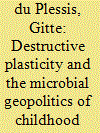| Srl | Item |
| 1 |
ID:
078029


|
|
|
|
|
| Publication |
2007.
|
| Summary/Abstract |
A concentration index methodology to analyze the inequality in childhood malnutrition in China is outlined. Height-for-age z-score is used as a measure of childhood malnutrition. Using household survey data from nine Chinese provinces, we found that per capita household income, household head's education, urban residence and access to a bus stop are associated with lower malnutrition. Child's age has a nonlinear relationship with the malnutrition status. Income growth and access to public transportation are associated with less severe inequality, while rural-urban gap, provincial differentials, and unequal distribution of household head's education are associated with higher levels of inequality in childhood malnutrition. Gender is not relevant for either malnutrition status or inequality. Investments in infrastructure and welfare programs are recommended to ameliorate the inequality in childhood malnutrition
|
|
|
|
|
|
|
|
|
|
|
|
|
|
|
|
| 2 |
ID:
193310


|
|
|
|
|
| Summary/Abstract |
Engaging Catherine Malabou's philosophical work on biological plasticity, this article combines microbiological and geopolitical analysis of the deadliest manifestations of childhood malnutrition. At the scale of microbiology, childhood malnutrition is a devastating condition and a mystery to which it seems microbiomes – the ecosystems of microbes in the gut – hold a key. At the scale of geopolitics, childhood malnutrition is a calamity generated by racial capitalism, poverty, and underdevelopment. What should we do with the plasticity that makes us? Malabou asks. Engaging philosophically with the plastic materiality of microbiomes in childhood malnutrition, the article focuses on destructive plasticity as an ontological alternative to what science on malnutrition pursues as a problem of causality. This leads to an argument that medicine, as well as humanitarian, security, and development interventions, must reckon with the destructive plasticity of what is in essence a political disease of annihilation. The article ends by speculating on resistance via the biological act of nurturing.
|
|
|
|
|
|
|
|
|
|
|
|
|
|
|
|